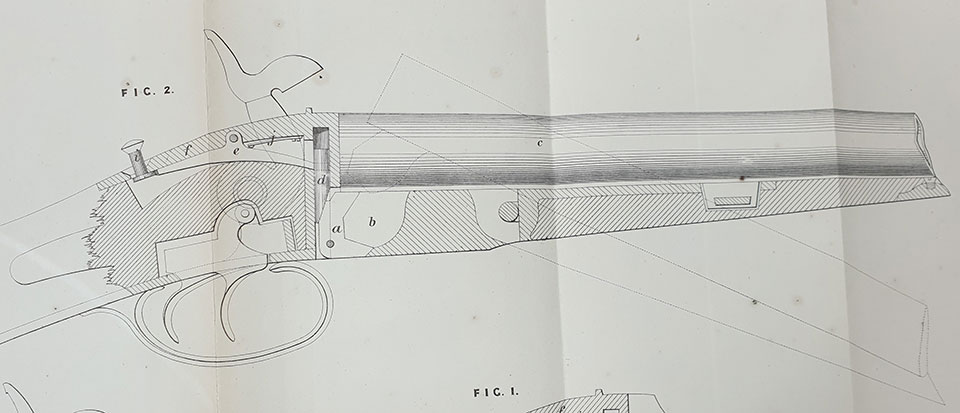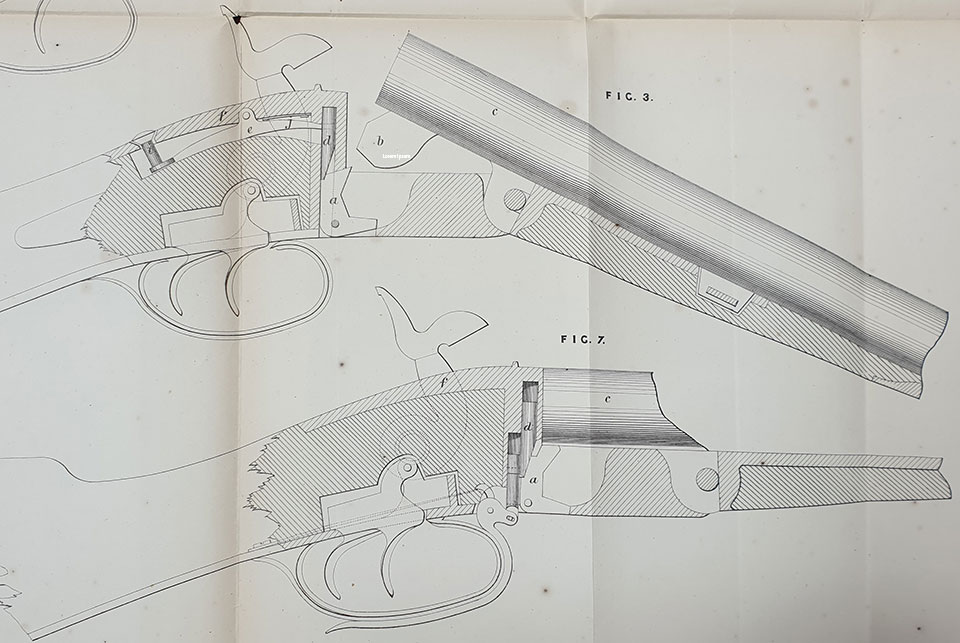As noted in my last article, James Purdey the Younger had, within five years of taking over his father’s company, created what has become the most successful locking system the gun trade has ever had for side-by-side guns. However, in 1863 that primacy was far from clear, and James had many competitors. As such, he continued inventing, and it is his next three patents, registered between 1865 and 1868, that are the subject of this article.
Patent No. 424, of 14 February 1865 – Single Bite Snap-Action & Others:
Although James had already invented a double-bite snap-action, it was not his only patent for a locking system. The second came in February 1865, when he patented a single-bite snap-action. As noted in the last article, this locked only on the rear lump, but James went some way towards overcoming the reduced mechanical advantage that system had. When the gun was closed, the rear lump would trip a rocking catch, which would snap down onto the rear lump. This was held in place by a wedge-ended vertical bolt, the top of which was connected via a lever under the top-strap to a button. Depressing the button lifted the wedge, allowing the lump to push the catch backwards, where it was held in position by the tip of the wedge. As such, the barrels did not have to overcome any mechanical resistance when closing. The design also described replacing the button with the more conventional underlever, which would operate on the wedge-bolt from below.

The patent had four other elements to it, any of which could also be used individually. Although the hammers in the patent specification are the shape of those associated with pinfire cartridges, the noses of which land on the breech-ends of the barrels, centrefire cartridges were now coming into use, and so there was now a need to build firing-pins (‘strikers’) into the action as well. James’ solution was to have these fitted horizontally through the breech face, with a projection at right-angles protruding from the rear of the striker. This indexed into a slot cut on the inside of the hammer breast, causing the striker to be pulled back as the hammer was brought to half cock. As such, while the thumb-spur of the hammer was required to cock the gun, the nose of the hammer was actually vestigial, as it had no interaction with the striker.
Only forty-one of these were ever sold by Purdey.
Another vestige of pinfire cartridges was a form of centrefire cartridge with a pin protruding from the rim, which could be used to extract it. These are depicted on a Bastin action, which operated very differently from either of Purdey’s in-house designs in that the barrels were pulled forward horizontally, rather than pivoting downwards. Only forty-one of these were ever sold by Purdey, all in pinfire, between 1861 and 1869. Due to their peculiar method of opening, they used a form of reverse extraction, where the pins of the cartridges would slide forward as the gun was opened until caught by holes in the tips of the hammer noses. This meant that, as the barrels were pulled forward, the pins were retained in those holes, and the barrels pulled off the cartridges. It seems possible that James intended his modified centrefire cartridge to be extracted in a similar way, although it would only have been applicable to Bastin actions.

The patent also covers two forms of extractors. The first again related to the Bastin action, and is simply two levers that rise through the bottom of the action, catching the lower rim of the cartridge against the breech-face. This would have a similar effect to the holes in the hammer noses, described above, but in this case the lever could be depressed by pushing on the other end, ensuring that, when only one barrel had been fired, only the fired case was extracted. This seems a very slow method of reloading, as well as being quite complex to operate. The second form of extractor, and the last of the inventions covered by the patent, was specific to the single-bite action described in the same patent. A spring-powered lever in the face of the action pressed on an ejector cam built into the rear lump of the barrels, pushing the extractors up.
Crudgington & Baker were unable to uncover an example of this single-bite action during their survey of shotgun actions, and so relied upon the patent to discuss it.
This patent is interesting, in as much as four of the five aspects covered were ideas that Purdey seems never to have actually made. Crudgington & Baker were unable to uncover an example of this single-bite action during their survey of shotgun actions, and so relied upon the patent to discuss it. If this is the case, then the second extractor patent may also never have been used. The same also appear to be true for the centrefire cartridge and Bastin extractors. The only design that is known to have been used is the firing-pins operated by vestigial pinfire hammers. Although they look like conversions, it is entirely possible that at least some of these were made as centrefire guns. If that is the case, then they were constructed alongside the classic percussion-style fence and striker arrangement, which was used on the first Purdey centrefire gun (6992). It is possible that they were intended to produce guns in a style that more conservative owners had grown accustomed to shooting, as has occasionally happened throughout the company’s life. Unfortunately, the records just do not say.

Patent No. 1464, of 25 May 1866 – Loaded Indicators
This is one of a group of patents that all appeared around 1865/6, seemingly designed for an obvious concern of shooters – whether the gun was loaded or not. With the invention of centrefire cartridges, it was no longer possible to tell whether a gun was primed or not. Even the pinfire cartridge had an obvious warning, with the brass pin protruding through the top of the barrel. In an attempt to allay client’s fears, several gunmakers came up with various solutions to this problem, four of whom took the route of effectively replicating the pinfire case, with a steel pin which would be raised when a cartridge was in the chamber. In James’ design, a small angled lever was let into the top of the breech-face, which would be pushed flush with the breech-face if a cartridge was chambered. On the other end of the lever was the pin, which would be raised up by that pressure, allowing the firer to know whether the chambers were loaded or empty even by touch, as well as sight. Interestingly, the first centrefire gun, referred to above, has these loaders let into the tops of the fences. It seems likely, therefore, that 6992 was retained for further experimentation, and probably sold at a later date than its number suggests.
Patent No. 2319, of 23 July 1868 – Adjustable Elevation for the Breech
This patent relates more to the fit than the function of a gun, providing the same adjustment as an elevated rib, a concept which had first been introduced by Joseph Manton in 1806. Many of Purdey’s guns at that time were fitted with either ‘semi-bottom’ or ‘bottom’ ribs. These were set down between the barrels, and in the case of the latter actually exposed the breech-face between the breech-ends. While they allow for a slight reduction in weight, they are obviously virtually invisible to the user when firing. James’ solution, in essence, was to have a plate screwed onto the top tang and over the breech, which could be adjusted up or down by turning a screw. This would only work on a gun that was not fitted with a toplever, as in that case the two would have occupied the same space. However, once again it is not known whether any guns were ever fitted with these devices.
Many of Purdey’s guns at that time were fitted with either ‘semi-bottom’ or ‘bottom’ ribs.
These three patents may appear as relative missteps today, given their lack of success compared to the Purdey Bolts. However, they have to be viewed within the context of their time, where the bolts were not initially well received, and every new idea must have seemed to possess the potential to be the ‘next big thing’. That there is no record of Purdey ever utilising a particular design does not necessarily signify failure either. Should someone have come up with a design which relied upon even part of his existing patent, then he would be able to charge royalties and secure an income by that method. As it was, those that were worked provided the company with something to separate itself from the competition, and where used by others also gave a small income of royalties. None were quite as adaptable as the Purdey Bolts, but James had yet more ideas to come.
Dr Nicholas Harlow is Gunroom Manager at James Purdey & Sons, in London.
Published by Vintage Guns Ltd on



